Sanctuary of Apollo, Cyrene
Archaeological Development
The first shrine at this site dates from the 7th century BC. During the 6th century it was rebuilt — the new, largely Doric temple included a large cella but had no pronaos (front porch) or opisthodomos (rear porch). Instead of the latter there was an adyton at the back of the cella, which is believed to have been used as a treasury. It was slightly shorter than the standard temple; only 11 columns long in comparison to the standard 13. The upper parts of the building were constructed from mud brick. Inside super-imposed columns created two tiers.1 Towards the end of the century, the temple was upgraded to include and outer colonnade and a decorated frieze.2
In the 4th century it was rebuilt in a new archaeological style, with less inspiration taken from Thera — the colony’s metropolis. The old columns were removed and used in the foundations. New, thicker columns were needed to support the additional weight of a fully stone temple; creating a more monumental structure.3 It is believed that at this period the ground level was raised and the new temple was built upon the terrace. This left a 17 foot drop from the entrance to floor-level and is the first known example of a depressed cella.4 Opai (roof openings to allow in sunlight) were paid for by the citizens.5
This temple lasted until the Roman period but was burnt down during the Jewish Rebellion of 115-117 AD.6 Again it was rebuilt, this time in a Doric style. It has also been speculated that this was the time of the ground level change. It was damaged in an earthquake in the 3rd century but was later repaired. The Baths of Trajan were also constructed in the sanctuary during the Roman period, dating from c.100 AD.
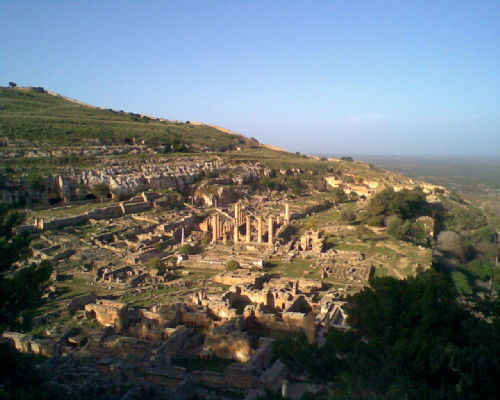
Fig. 1: View of the Temple of Apollo from the North East.
Gods/Heroes
The specific epithet of Apollo worshiped in the sanctuary was ‘Karneios,’ the god of the ram. This cult derived from Sparta. A specific monument was erected to the deity towards the end of the 4th century in the sanctuary. Apollo was an important god for the city as both foundation myths credit him for the city’s creation.7
Within the sanctuary, shrines to Isis, Persephone, Hades and Hecate have been discovered. There was also a small temple of Artemis - explaining the passages referencing to her in the Sacred Law. With Artemis and Apollo being twins, the worship of both in the same sanctuary is understandable.
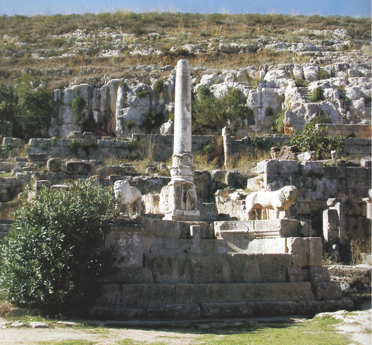
Fig. 2: Monument to Apollo Karneios.
Ritual Activity
Sacrifice-
Apart from a 22m long monumental altar in front of the temple, there is little material evidence for sacrifice at the sanctuary. However there are references to animal sacrifice at the Temple of Apollo in Pindar's 5th Pythian Ode.8
Dedications-
The cult statue from the temple is now in the British Museum. It is believed that it was only sculpted for the third, Roman incarnation of the temple from the 2nd century AD; when it was likely paid for by the rich Roman citizens of Cyrene. It was discovered in 121 pieces next to the pedestal where it once stood. At 2.29m tall, it is slightly above life size. Other than this no dedications survive.
Festivals-
The main festival celebrated at the Sanctuary of Apollo was the Karneia. This primarily Spartan festival took place for 9 days in late summer - roughly between mid-August and mid-September. The Karneia was celebrated because Cyrene's metropolis, Thera, was a colony of Sparta. The festival included musical performances,9 the chasing of the staphylodromoi (a rite to bring good luck onto the city) and sacrifices.10 The festival in Cyrene was referenced by Pindar in the 5th Pythian Ode.11 During the festival there was a sacred truce and no military activity could take place. This was demonstrated in Herodotus, where the Spartans could not commit men to the Battle of Thermopylae due to the Karneia.12
Rules and Regulations
The Sacred Law of Cyrene stood on a marble block outside the Temple of Apollo until the Roman period, when it was reused in the foundation of the baths to the East of the Sanctuary. The details of the Sacred Law came from the Oracle at Delphi. It is unsure when the Pythia was consulted on this matter, perhaps as it was such a well known story nobody thought to write it down. It served as a reminder of the rules and regulations of the sanctuary. As well as the Sacred Law, the block was inscribed with details of a grain shipment during a famine in Greece. This allows the block to be dated to the period 330-325 BC.
Much like other Sacred Laws, this one is incredibly detailed in its specifications — for example requiring a red billy goat for a sacrifice during times of famine or sickness. The block references to the possibility that individuals may intentionally try to gain pollution.13 This is evidence that miasma was not necessarily a bad thing. The priests at the temple realised that the system was being abused and formulated this section of the law, ensuring that those who deliberately incur pollution have a significantly greater forfeit.
Whilst everyday ways of acquiring pollution are mentioned, most of the detail revolves around rare occurrences such as birth, death and marriage. This would indicate that these events required a greater level of purification. If this depth was needed for all cases of miasma, individuals would ignore the regulations. Those who did go to extreme lengths were parodied in Theophratus’ Superstitious Man.
The inscription shows that tithes were used as a means of exhorting money out of the population. Such a large proportion of the law dedicated to tithes demonstrates their importance to the sanctuary. The wood in the sanctuary, once purchased, could be used for any purpose either sacred or secular showing that there was often little boundary between the two.
Historical Significance
Unusually for a Greek Polis, Cyrene was a monarchy, ruled by the Battid dynasty. They kept their position as Client Kings after submitting to the Persians c.525 BC.14 However there was tension in the city between the aristocrats and the monarchy, which led to a rebellion overthrowing the dynasty in c.440 BC.15 Following Alexander’s conquests the city fell into the hands of Ptolemaic Egypt and then Rome in the 1st century BC.
The history of the city had an impact on the sanctuary of Apollo. The temple’s first incarnation was originally inspired by the architecture of Thera, the metropolis of Cyrene. When it was rebuilt in the late 4th century, shortly after the overthrow of the monarchy these Theran influences were intentionally discarded.16
This change occurred because the monarchy had used the Theran foundation myth to legitimise their rule. This story says that Battus accompanied the King of Thera to Delphi. The King, Grinnus, was instructed to found a city in Libya by the Pythia. As he was too old to do so personally, the priestess nominated Battus to lead the colonisation. Battus did so and his descendants became the Kings of Cyrene.17 The aristocrats preferred the myth involving the nymph Cyrene sleeping with Apollo, since it did not validate the rule of the monarchy. Therefore they symbolically cut their links with Thera by moving to a new architectural style.
The royal and aristocratic preferences for different stories is shown in Pindar. The Pythian Ode dedicated to King Arcesilaus for winning the chariot race in 462 uses the Battus myth as legitimisation of Battid rule.18 The one devoted to the aristocrat Telesicrates for winning the 474 footrace in armour instead uses the Cyrene and Apollo myth.19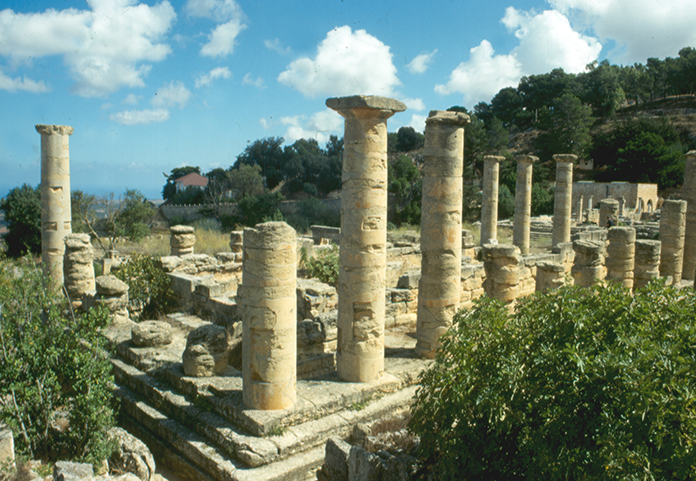
Fig. 3: The Temple of Apollo.
Who used the site, and where did they come from?
The site would almost exclusively used by the local Cyrenians. This was not a pan-Hellenic sanctuary where people would travel from across the Greek world to visit, not was it of particular importance to any section of society - such as a temple on an important promontory would be to sailors for example. This resulted in the Temple of Apollo primarily being used by locals and the occasional visitor.
Location
The Sanctuary of Apollo at Cyrene was located in the North West of the city. This location was where, according to myth, Apollo slept with the nymph Cyrene whom he named the city after. To the South was the acropolis, which was the location of the Royal Palace and the source of the sacred spring, known as the Fountain of Apollo, which ran through the sanctuary. This spring was mentioned by both Herodotus and Pindar.20
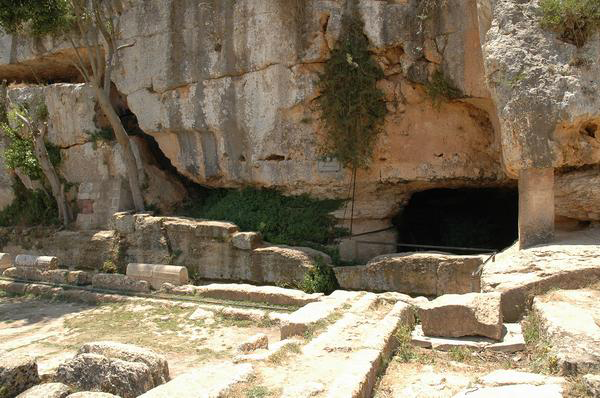
Fig. 4: Where the Fountain of Apollo flowed from the acropolis.
Site Plan
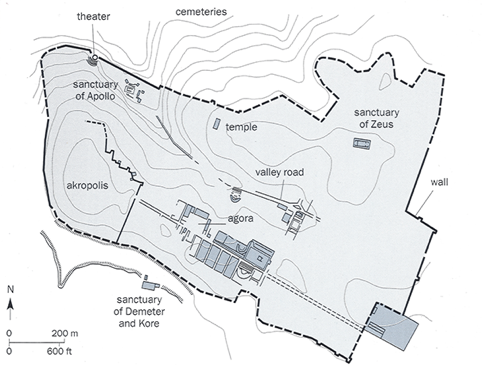
Fig. 5: Map of Cyrene during the Greek Period.
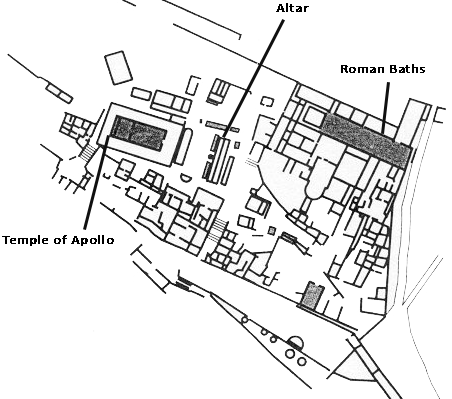
Fig. 6: Map of the Sanctuary of Apollo.
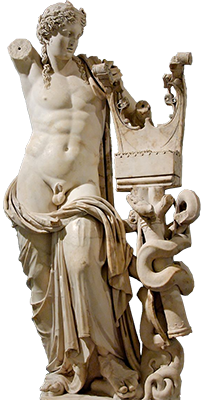
Fig. 7: 2nd century AD Cult Statue of Apollo.
Select Site Bibliography
Primary Sources-
Herodotus, The Histories, trans. A. de Selincourt, revised J. Marincola (London: Penguin, 1996)
Pindar, The Odes of Pindar, trans. J. Sandys (London, Cambridge: Loeb, 1915)
Secondary Sources-
Dinsmoor, W.B. (1902) The Architecture of Ancient Greece (London: B.T. Batsford Ltd.)
Hornblower, S. ‘Arcesilaus’ in A.J. Spawforth and S. Hornblower (eds) (1996) Oxford Classical Dictionary, 3rd edn (Oxford University Press: Oxford) pg 140.
Kearns, E. (2010) Ancient Greek Religion (Chichester: Wiley & Blackwell)
Neer, R.T. (2012) Art and Archaeology of the Greek World (London: Thames & Hudson)
Parker, R.C.T. ‘Carnea’ in A.J. Spawforth and S. Hornblower (eds) (1996) Oxford Classical Dictionary, 3rd edn (Oxford University Press: Oxford) pg 293.
Robertson, N. (2010) Religion and Reconciliation in Greek Cities (Oxford: Oxford University Press)
Rhodes, P.J. & Osborne, R. (2007) Greek Historical Inscriptions, 404-323 BC (Oxford: Oxford University Press)
Spawforth, T. (2006) The Complete Greek Temples (London: Thames & Hudson)
Winter, F.E. ‘Tradition and Innovation in Doric Design II: Archaic and Classical Doric East of the Adriatic’ in American Journal of Archaeology Vol. 82, No. 2 (Spring, 1978), pp. 151-161.
Footnotes
1- Winter (1978), 151ff.
2- Neer (2012), 249.
3- Dinsmoor (1902), 220.
4- Dinsmoor (1902), 267.
5- Spawforth (2006), 90.
6- Spawforth (2006), 90.
7- Neer (2012), 249.
8- Pindar, The Odes of Pindar, Pythian 5.77ff.
9- Neer (2012), 249.
10- Parker (1996), 293.
11- Pindar, The Odes of Pindar, Pythian 5.80.
12- Herodotus, The Histories, 7.206.
13- Rhodes and Osborne (2007), no.97, line 41.
14- Herodotus, The Histories, 4.203.
15- Hornblower (1996), 140.
16- Neer (2012), 250.
17- Herodotus, The Histories, 4.150ff.
18- Pindar, The Odes of Pindar, Pythian 4.1ff.
19- Pindar, The Odes of Pindar, Pythian 9.1ff.
20- Herodotus, The Histories, 4.158.
List of Illlustrations
Fig. 1: Wikimedia Commons:
http://commons.wikimedia.org/wiki/File:Cyrene8.jpg (accessed 16 Jan 2014).
Fig. 2: Neer (2012) p. 250.
Fig. 3: Wikimedia Commons:
http://commons.wikimedia.org/wiki/File:CireneSantuarioApolloPortico.jpg
(accessed 18 Jan 2014).
Fig. 4: Livius: http://www.livius.org/pictures/libya/cyrene/downtown/fountain-of-apollo (accessed 18 Jan 2014).
Fig. 5: Neer (2012) p. 247.
Fig. 7: Wikimedia Commons:
http://commons.wikimedia.org/wiki/File:Apollo_Kitharoidos_BM_1380.jpg
(accessed 17 Jan 2014).
